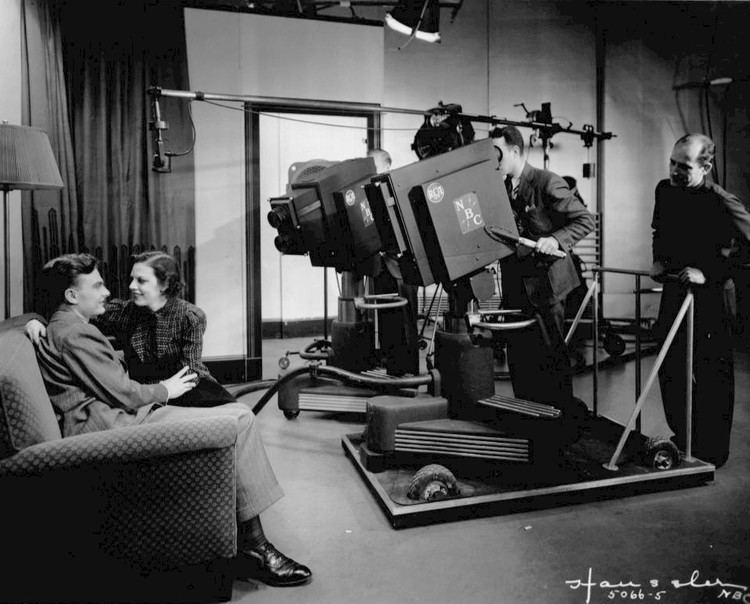 | ||
441 lines, or 383i if named using modern standard, is an early electronic television system. It was used with 50 interlaced frames per second in France and Germany, where it was an improvement over the previous 180-line system. In the United States it was used by RCA with 60 frames per second from 1938 to 1941.
Contents
Use in Germany
After trials in 375 lines during the Berlin Olympic Games of 1936, by 1937 Germany had introduced a 441 lines with 50 interlaced fields per second television system that replaced the previous 180 lines network relayed by a special Reichspost (National Post Office) cable network in the country's main cities (Berlin, Hamburg, Munich, Bayreuth, Nuremberg). The system's line frequency was 11025 Hz and the broadcast frequencies were 46.0 MHz for vision and 43.2 MHz for sound. Its image aspect ratio was close to 1.15:1.
A project began in 1938 involving the National Post and several companies including Bosch, Blaupunkt, Loewe, Lorenz, TeKaDe and Telefunken that aimed to produce 10,000 units of the television system. However, due to the onset of the Second World War only about 50 devices were installed in military hospitals and various government departments. The transmitter's aerials in Berlin were destroyed during an Allied Forces' bombing in November 1943, but the station was also relayed by a special coaxial cables network to "wide screen" public "TV-rooms" (fernsehstuben) so it carried on this way until 1944. Sample programme on YouTube [1]
Einheitsempfänger
The Einheitsempfänger is a German TV receiver created in 1939. It could only receive one channel, since its receiving frequency was preset at the factory. This allowed for lower prices and would have made difficult the reception of foreign channels (broadcasting in the same system), were any of them available.
To date, only a few surviving and functioning units are known:
Technical Data for a typical set
Use in France
By 1941 the "Fernsehsender Paris" station transmitted from the Eiffel Tower in Paris using the German 441 lines system and its main technical characteristics. Television programs were mainly for wounded soldiers of the Wehrmacht occupation troops who recovered in the Greater Paris Area hospitals, but they also included French-language shows. Broadcasts were monitored in the United Kingdom during the Second World War to gather intelligence information from occupied France. Because the 819 lines standard had been adopted in 1948 for the national network, it was due to cease on January 1, 1958. However, after a long elections coverage night, most of the equipment was destroyed by fire on January 3, 1956. It was decided to indemnify the 3,000 owners of remaining 441 lines sets and to entitle them to reduced rates for their new 819 lines receivers. Since July 1952 the 441 lines transmitter was no longer broadcasting separate programs, but simply picked up the national network's picture through an 819-441 lines "optical converter" (a 441 lines camera, slightly out of focus, pointed at an 819 lines monitor equipped with an oval spotlight cathode ray tube).
The line frequency was 11025 Hz with vision broadcast at 46.0 MHz and sound at 42.0 MHz. Aerials were independent for audio and vision at the top of the Eiffel tower, both vertically polarized. No gain being obtained from these pre-war basic aerials, the effective radiated power was only the transmitter's peak one, i.e. 30 kW which enabled a good reception in a radius of 100 km around Paris. As displayed in J.M. Frost's WRTH (World Radio TV Handbook) editions at that time, the transmitter's frequencies (42-46 MHz) were listed as channel "S" (or "Special" channel) in the European Broadcasting Union's official documents.
Use in Italy
Replacing pre-war tests in 343 lines, broadcasts using the 441 lines system began in Italy in 1939 with regular services from Rome using 2 kW power and Milan using 400 W power in the frequency band of 40-45 MHz. Broadcasts were discontinued on May 31, 1940.
As in France, all technical data - VHF frequencies excepted - were identical to those in use in Germany.
United States
Field tests in Los Angeles on various line systems began in 1936, and the United States had adopted RCA's 441-line system by 1938. The following year the first pre-built TV receivers were sold on a very limited basis, mostly in New York City, the new system being publicly launched by NBC during the New York World's Fair in April 1939. Its manufacturers included RCA, General Electric, DuMont, and Andrea. Following a decision of the NTSC (National Television System Committee), the 525-line standard replaced the 441-line standard on July 1, 1941.
